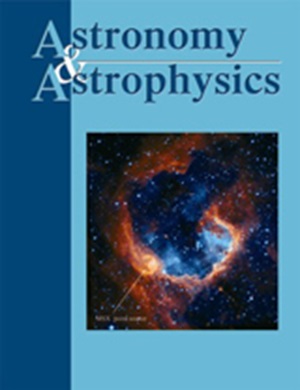The XMM deep survey in the CDFS
IF 5.8
2区 物理与天体物理
引用次数: 11
Abstract
We present the X-ray spectra of 185 bright sources detected in the XMM-Newton deep survey of the Chandra Deep Field South with the three EPIC cameras combined. The 2–10 keV flux limit of the sample is 2 × 10−15 erg s−1 cm−2. The sources are distributed over a redshift range of z = 0.1−3.8, with 11 new X-ray redshift measurements included. A spectral analysis was performed using a simple model to obtain absorbing column densities, rest-frame 2–10 keV luminosities, and Fe K line properties of 180 sources at z > 0.4. Obscured AGN are found to be more abundant toward higher redshifts. Using the XMM-Newton data alone, seven Compton-thick AGN candidates were identified, which set the Compton-thick AGN fraction at ≃4%. An exploratory spectral inspection method with two rest-frame X-ray colours and an Fe line strength indicator was introduced and tested against the results from spectral fitting. This method works reasonably well to characterise a spectral shape and can be useful for a pre-selection of Compton-thick AGN candidates. We found six objects exhibiting broad Fe K lines out of 21 unobscured AGN of best data quality, implying a detection rate of ∼30%. Five redshift spikes, each with more than six sources, are identified in the redshift distribution of the X-ray sources. Contrary to the overall trend, the sources at the two higher redshift spikes, at z = 1.61 and z = 2.57, exhibit a puzzlingly low obscuration.XMM在CDFS中的深度巡天观测
我们展示了在钱德拉深场南区 XMM-Newton 深度巡天中用三台 EPIC 相机探测到的 185 个明亮光源的 X 射线光谱。样本的 2-10 keV 通量极限为 2 × 10-15 erg s-1 cm-2。这些源分布在 z = 0.1-3.8 的红移范围内,其中包括 11 个新的 X 射线红移测量值。利用一个简单的模型进行了光谱分析,获得了 180 个 z > 0.4 的源的吸收柱密度、静止框 2-10 keV 光度和铁 K 线特性。研究发现,被遮挡的 AGN 在较高红移时更为丰富。仅利用 XMM-Newton 数据就确定了 7 个康普顿厚 AGN 候选天体,从而将康普顿厚 AGN 的比例设定为 ≃4%。引入了一种探索性光谱检测方法,使用两种静帧 X 射线颜色和一种铁线强度指标,并与光谱拟合结果进行了对比测试。这种方法可以很好地描述光谱形状的特征,对于预选康普顿厚AGN候选者很有用。在 21 个数据质量最佳的未遮挡 AGN 中,我们发现了 6 个表现出宽铁 K 线的天体,这意味着探测率达到了 30%。在X射线源的红移分布中发现了五个红移峰值,每个峰值都有六个以上的源。与总体趋势相反,位于两个较高红移峰值(z = 1.61 和 z = 2.57)的源表现出令人费解的低遮蔽性。
本文章由计算机程序翻译,如有差异,请以英文原文为准。
求助全文
约1分钟内获得全文
求助全文
来源期刊

Astronomy & Astrophysics
ASTRONOMY & ASTROPHYSICS-
自引率
27.70%
发文量
0
期刊介绍:
Astronomy & Astrophysics is an international Journal that publishes papers on all aspects of astronomy and astrophysics (theoretical, observational, and instrumental) independently of the techniques used to obtain the results.
 求助内容:
求助内容: 应助结果提醒方式:
应助结果提醒方式:


